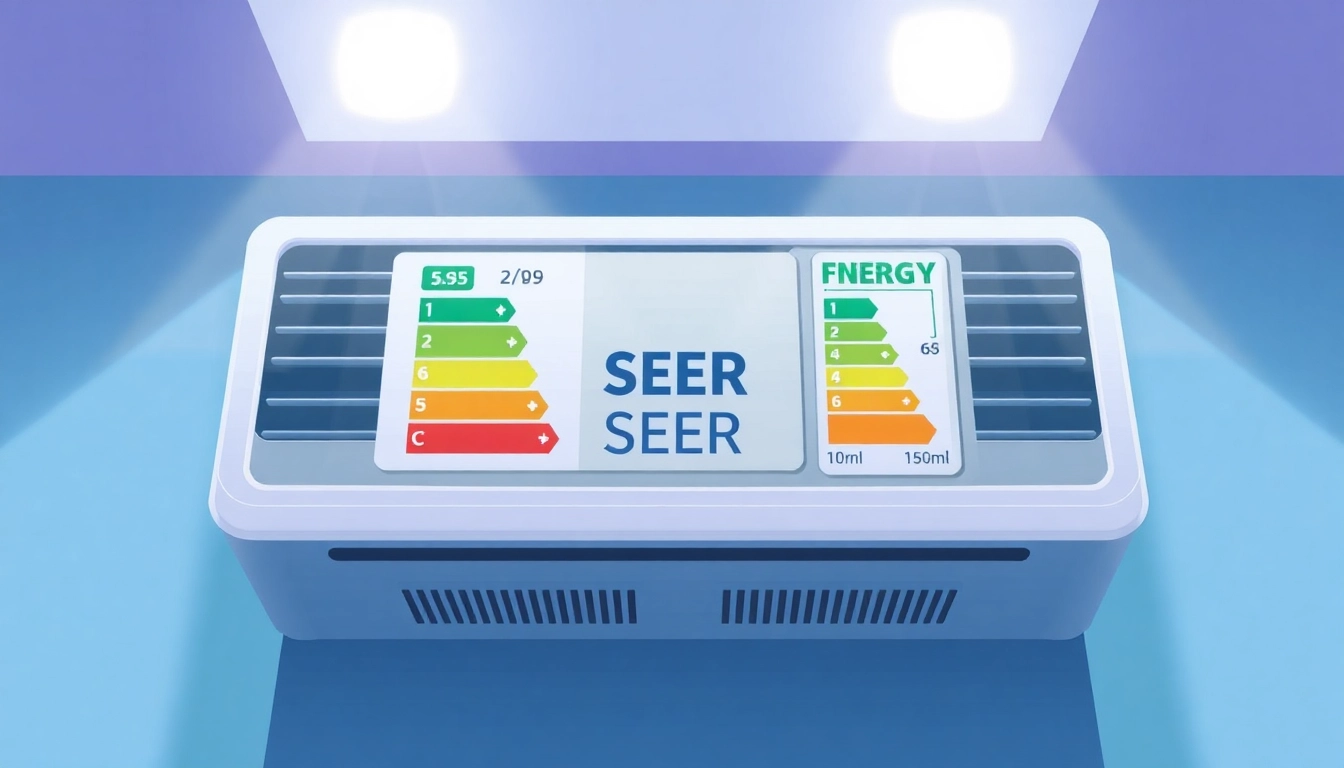Understanding What is a SEER Rating for AC: Your Guide to Energy Efficiency

What is a SEER Rating?
Definition and Explanation of SEER
SEER, or Seasonal Energy Efficiency Ratio, is a critical metric used to evaluate the efficiency of air conditioning systems. It represents the ratio of the cooling output (in BTUs) provided by the air conditioner over a typical cooling season, divided by the total energy input (in watt-hours) consumed by the unit during that same period. In simpler terms, a higher SEER rating indicates a more efficient air conditioning unit, capable of providing more cooling while using less energy.
The advent of SEER ratings has transformed how consumers evaluate air conditioning systems, guiding them towards energy-efficient options. For a comprehensive exploration of SEER ratings, including how they apply to various air conditioning units, you can learn more about what is a seer rating for ac.
Importance of SEER in Air Conditioning
Understanding SEER ratings is essential for both economic and environmental considerations. Economically, an air conditioning unit with a higher SEER rating will typically result in reduced energy consumption, leading to lower electricity bills over time. Additionally, many utility companies offer rebates for consumers who purchase high-efficiency units, further incentivizing the switch to systems with superior SEER ratings.
From an environmental perspective, choosing a high-efficiency air conditioning system contributes to a reduction in greenhouse gas emissions and fossil fuel consumption. As the world moves towards more sustainable practices, efficient air conditioning systems play a crucial role in achieving energy conservation goals.
How SEER is Calculated
To calculate the SEER rating, manufacturers measure the total cooling output during a standard cooling season (expressed in British thermal units or BTUs) and then divide this by the total energy consumed (measured in watt-hours). The formula can be succinctly summarized as follows:
SEER = Total BTUs of Cooling Output / Total Watt-Hours of Energy Consumed
Regulatory bodies outline strict testing protocols to ensure that any SEER rating provided for an air conditioning unit is accurate, utilizing standardized outdoor temperature conditions and indoor air temperature settings. This systematic approach helps consumers make informed decisions based on comparable efficiency ratings.
Benefits of High SEER Ratings
Energy Savings and Cost Efficiency
One of the most significant benefits of high SEER ratings is the potential for energy savings. A unit with a higher SEER can significantly reduce energy consumption compared to lower-rated models, making it financially advantageous over the long term. For instance, moving from a standard 10 SEER air conditioner to one rated at 16 SEER can result in up to a 60% decrease in energy consumption during peak cooling months.
The initial cost of a high SEER unit might be higher, but this cost is often offset by the savings on electricity bills. Homeowners should evaluate their monthly operating expenses and consider the long-term returns that come from investing in energy-efficient systems. This financial calculus often aligns with sustainability efforts, as it reduces both environmental impact and operational costs.
Environmental Impact
High SEER-rated air conditioning units are designed to use less energy, which inherently reduces their environmental footprint. This energy efficiency translates to lower carbon dioxide emissions as less power generation is required. According to estimates from the U.S. Environmental Protection Agency (EPA), improving the efficiency of HVAC systems could significantly reduce greenhouse gas emissions on a national and global scale.
Moreover, by choosing a high-efficiency air conditioning system, homeowners contribute to a nationwide initiative aimed at reducing reliance on fossil fuels and combating climate change. Each energy-saving choice collectively leads to a more sustainable future.
Long-Term Value of Installation
Investing in a high SEER-rated air conditioning system can also increase a property’s resale value. Potential buyers often favor homes that are equipped with energy-efficient appliances, viewing them as preferable not just for lower operating costs but also for environmental reasons. Real estate studies show that homes with high-efficiency systems tend to sell faster and at higher market values than those with less efficient counterparts.
Furthermore, many high-SEER systems are built with advanced technology, often leading to better overall performance, temperature control, and comfort levels in the home. The long-term reliability and reduced maintenance needs of these units can also mean fewer repairs and longer lifespans.
Determining the Right SEER Rating for Your Needs
Choosing Based on Climate
The local climate plays a vital role in determining the appropriate SEER rating for air conditioning systems. In hotter climates, such as Texas, where air conditioning is essential for much of the year, investing in a higher SEER unit makes more sense financially. Ratings of 16 or above are often recommended for regions with extended hot summers.
Conversely, in milder climates where air conditioning usage is minimal, homeowners may find that investing in lower SEER-rated models could be sufficient, limiting initial costs while still providing adequate cooling during occasional hot days.
Understanding Your Usage Patterns
In addition to climate considerations, it’s crucial to assess usage patterns. Households with high occupancy and frequent use of air conditioning will benefit more from higher SEER systems, as the energy savings become apparent with increased usage. In cases where air conditioning is used sparingly, a lower SEER system might prove to be sufficient.
Some homeowners may opt for smart thermostats that track and optimize usage patterns, allowing for targeted cooling and improving overall efficiency, which can be a complementary strategy when selecting the right SEER rating.
Balancing Cost and Efficiency
Balancing the cost of installation and the ongoing efficiency of an air conditioning unit is a critical decision-making factor. Higher SEER-rated units typically come with a larger price tag; however, the investment should be analyzed in the context of long-term energy savings. Homeowners should conduct a cost-benefit analysis to determine the payback period for different SEER-rated options.
Many HVAC professionals recommend calculating expected energy savings against the initial investment to arrive at a more informed decision. Tools and calculators designed for this purpose can help homeowners estimate their return on investment based on energy consumption and local utility rates.
Comparing Different SEER Ratings
SEER Rating Scale Overview
The SEER rating scale ranges from a minimum of around 13 for central air conditioning systems, up to 25 or more for high-efficiency options. The U.S. Department of Energy has implemented benchmarks to guide industry standards and consumer expectations effectively. Understanding the scale can help homeowners make informed decisions based on their cooling needs and budget constraints.
The introduction of SEER2 ratings, which refine the measurement process by providing more accurate data under real-world conditions, is set to further enhance the reliability of SEER as a metric for evaluation. This adjustment signifies a shift towards measuring efficiency more accurately under various operational environments.
Pros and Cons of Various Ratings
When evaluating SEER ratings, it’s essential to understand the advantages and disadvantages associated with different levels. For example:
- Low SEER Ratings (13-15): Generally more affordable but can lead to higher energy costs in hotter months.
- Moderate SEER Ratings (16-18): A balance of cost and efficiency, suitable for most residential installations.
- High SEER Ratings (19+): Most efficient but also the most expensive upfront; excellent for long-term savings in warmer climates.
Assessing these trade-offs is critical, and homeowners should perform detailed fiscal evaluations to justify their investments.
Future Trends in SEER Standards
The HVAC industry is shifting towards more rigorous standards, driven by environmental concerns and energy efficiency mandates. The adoption of SEER2 ratings reflects this trend, as measuring efficiency under realistic conditions is becoming increasingly important. Expectations for future trends include higher minimum efficiency standards, which will likely make high SEER units more commonplace.
Technology advancements will also shape future models, leading to smarter air conditioning units with integrated environmental monitoring and adaptive settings that enhance efficiency even further. As manufacturers strive to meet the evolving demands of consumers and regulatory requirements, homeowners will reap the benefits of state-of-the-art air conditioning solutions that promise both comfort and sustainability.
FAQs About SEER Ratings
What is a Good SEER Rating?
A good SEER rating typically ranges between 16 and 20. For homeowners concerned about energy costs and environmental impact, aiming for a unit with a SEER of at least 16 or above is usually advisable to ensure optimal efficiency and savings over the system’s operational life.
Is Higher SEER Always Better?
While higher SEER ratings often provide better energy efficiency, they may not be necessary for every household. It’s essential to consider usage patterns, climate, and budget. For some homes, a mid-range SEER unit strikes a perfect balance between cost and energy efficiency, making it more practical.
How to Find Your Unit’s SEER Rating
To determine your air conditioning unit’s SEER rating, check the unit’s specifications label, usually located on the outside or inside of the unit. Additionally, homeowners can consult the manufacturer’s documentation or website for detailed information. HVAC professionals can also provide insights during maintenance visits.



Leave a Comment